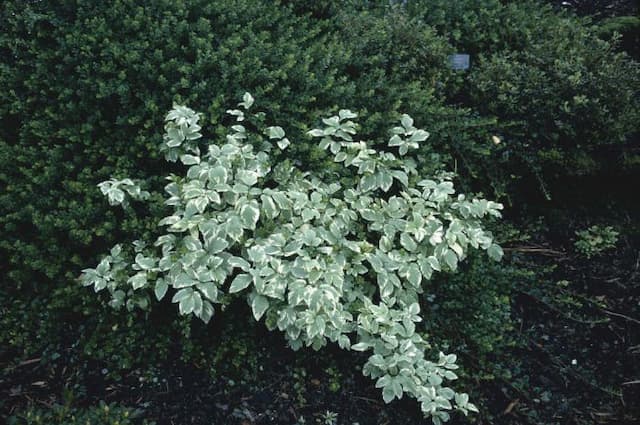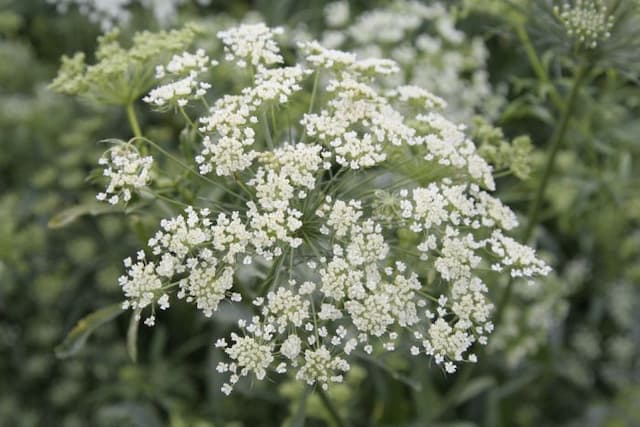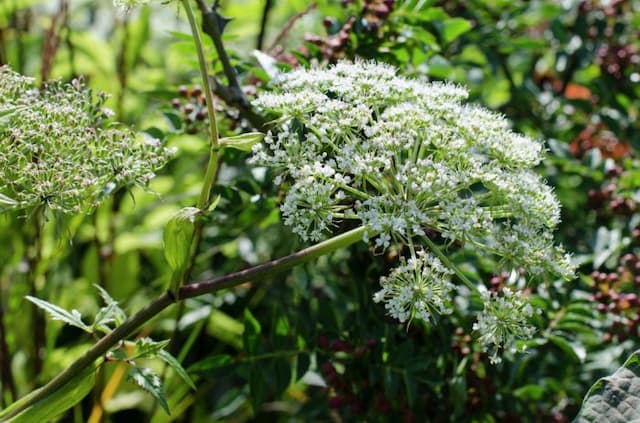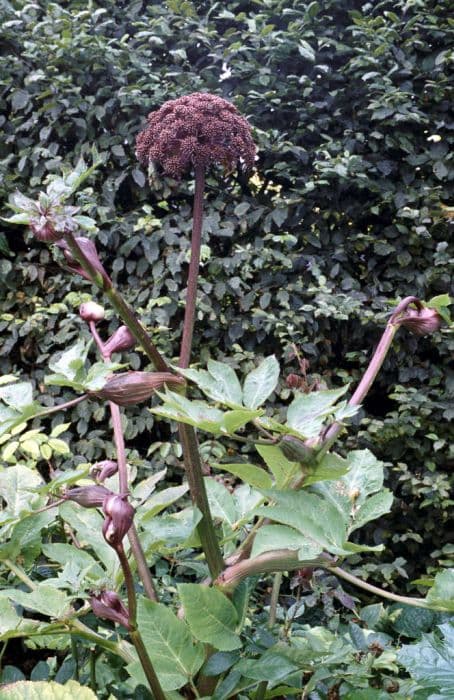Amethyst Sea Holly Eryngium amethystinum

ABOUT
Eryngium amethystinum, commonly known as amethyst sea holly, is a striking perennial plant admired for its ornamental appearance. The foliage of this eye-catching plant forms a rosette of dark green leaves with a spiny texture, resembling somewhat the leaves of a holly plant. These basal leaves often have a hint of blue in them, which adds to the plant's visual appeal. The most distinctive feature of amethyst sea holly is its flower heads, which are cone-shaped and composed of small, tightly-clustered, metallic blue or amethyst-colored flowers. These flowers are surrounded by a ruff of spiny bracts, which are also typically tinted with a similar blue or violet hue. When in bloom, the contrast between the striking flower heads and the green leaves is quite dramatic. The stems of the plant are branched and upright, often taking on a silvery-blue appearance, and the entire plant is known for its stiff and thorny texture. The unique color and structural form of amethyst sea holly make it a popular choice for dried flower arrangements, as well as fresh bouquets, where it offers an excellent focal point due to its unusual and captivating look.
About this plant
 Names
NamesFamily
Apiaceae
Synonyms
Amethyst Sea Holly, Amethyst Eryngo
Common names
Eryngium amethystinum
 Toxicity
ToxicityTo humans
The plant commonly known as amethyst sea holly is not widely recognized as poisonous to humans. There is no well-documented evidence to suggest that Eryngium amethystinum poses a significant toxicity risk when ingested by humans. However, it is generally advisable to avoid consuming any plant parts if you are not certain of their edibility or potential effects.
To pets
Amethyst sea holly is not commonly known to be toxic to pets. There is no significant data suggesting that Eryngium amethystinum presents a risk of poisoning if pets were to ingest it. Nonetheless, as with any non-food plant, it is usually recommended to prevent pets from ingesting the plant because individual animals might have sensitivities or allergic reactions.
 Characteristics
CharacteristicsLife cycle
Perennials
Foliage type
Deciduous
Color of leaves
Green
Flower color
Amethyst
Height
2 feet [60 cm]
Spread
1 foot [30 cm]
Plant type
Herb
Hardiness zones
5
Native area
Europe
Benefits
 General Benefits
General Benefits- Aesthetic appeal: Eryngium amethystinum, commonly known as "Amethyst Sea Holly," is prized for its striking appearance, featuring thistle-like flowers with a metallic blue or amethyst color that can add a unique and dramatic touch to gardens and landscapes.
- Drought tolerance: Amethyst Sea Holly is known for its ability to withstand dry conditions, making it suitable for xeriscaping or gardens in areas prone to drought.
- Attracts wildlife: The plant is beneficial to gardens as it attracts pollinators such as bees and butterflies, which are essential for the pollination of many other plants.
- Low maintenance: It requires minimal care once established, making it ideal for gardeners who prefer plants that do not require frequent attention or complex care routines.
- Deer and rabbit resistance: Amethyst Sea Holly is not a preferred food source for deer and rabbits, making it a good choice for gardens in areas where these animals are prevalent and may damage other plants.
 Medical Properties
Medical Properties- Diuretic effects: Eryngium amethystinum has traditionally been used to promote urine production, which can assist in flushing out the urinary tract.
- Anti-inflammatory properties: There is historical use of the plant for reducing inflammation, but contemporary evidence is lacking.
- Expectorant activity: The plant has been used to help clear mucus from the respiratory tract.
- Digestive aid: Eryngium amethystinum has been used in folk medicine to help with digestive issues, including stimulating appetite or addressing flatulence.
 Air-purifying Qualities
Air-purifying QualitiesThis plant is not specifically known for air purifying qualities.
 Other Uses
Other Uses- Decorative Elements: Eryngium amethystinum, commonly known as sea holly, is often used for its striking appearance in floral arrangements and boutonnieres, especially in dried form due to its ability to retain color and shape.
- Garden Bordering: Sea holly can be utilized as a border plant in gardens because of its unique foliage and thistle-like flowers that add texture and color contrast.
- Erosion Control: Due to its root system, sea holly can be planted on slopes or areas prone to erosion to help stabilize the soil.
- Permeable Paving: The plant can be used in permeable paving designs within landscapes to allow water to penetrate into the soil and reduce runoff.
- Artistic Inspiration: Artists and photographers often use sea holly as a subject or inspiration, thanks to its geometric flower heads and metallic blue color.
- Culinary Garnishing: Although not a common culinary herb, the plant can be used as an ornate and edible garnish for some specialty dishes.
- Theme Gardening: Sea holly plays a role in thematic gardens, such as medieval or apothecary gardens, due to its historical presence and unique aesthetic.
- Wildlife Habitat: Sea holly can be included in garden designs intended to attract and provide habitat for pollinators like bees and butterflies.
- Textile Dyeing: Historically, sea holly has been used in some regions to produce a blue dye for textiles, although it is not as commonly used for this purpose today.
- Seasonal Wreaths: The dried flowers of sea holly are a popular choice for creating long-lasting wreaths and other decorative crafts for the autumn and winter seasons.
Interesting Facts
 Feng Shui
Feng ShuiThe sea holly is not used in Feng Shui practice.
 Plant Symbolism
Plant Symbolism- Determination: Eryngium amethystinum, commonly known as Amethyst Sea Holly, often symbolizes a fierce determination due to its thorny and robust nature, which enables it to thrive in challenging conditions.
- Independence: Its ability to stand alone and maintain its unique beauty among other plants lends itself to represent independence and self-reliance.
- Protection: The spiky armor of the Amethyst Sea Holly suggests a sense of protection, making it a symbol for safeguarding oneself from harm.
- Royalty: The deep amethyst color of the flower is reminiscent of the royal gemstone, hinting at nobility and a regal essence.
 Water
WaterAmethyst sea holly should be watered deeply but infrequently to simulate natural drought-like conditions it thrives in. Initially, water once a week to establish the plant, ensuring roughly one to two gallons per plant, depending on the soil and weather conditions. Once established, reduce watering to every two to three weeks, unless there are extended dry periods. During hot, dry summers, water may be increased to once a week. Ensure the soil has good drainage as the amethyst sea holly does not tolerate waterlogged soils.
 Light
LightAmethyst sea holly requires full sun to grow at its best. The ideal spot would provide at least six to eight hours of direct sunlight daily. Avoiding shaded areas helps promote strong stems and vibrant flower color. Partial shade can be tolerated but may result in a leggier plant or less intense flowering.
 Temperature
TemperatureAmethyst sea holly can tolerate a wide temperature range but grows best in conditions that mimic its native habitat. The ideal temperature range is between 60°F and 75°F. It can survive minimum temperatures down to around 0°F and maximum temperatures well into the 90s, as long as appropriate care is given during extreme conditions.
 Pruning
PruningAmethyst sea holly should be pruned to remove spent flowers and encourage new growth. Pruning is best done after flowering, typically in late summer or early fall. Cutting the plant back by one-third can help maintain a compact shape and stimulate a second flush of blooms. Regular removal of dead or damaged stems is also beneficial for plant health.
 Cleaning
CleaningAs needed
 Soil
SoilSea holly thrives in well-draining soil with a pH range from 6.0 to 7.5. A mix of one part garden soil, one part coarse sand or perlite, and one part peat or compost will provide the ideal conditions for this plant's root system and aid in proper drainage and aeration.
 Repotting
RepottingSea holly (Eryngium amethystinum) does not need frequent repotting; it is often best to repot every 3-4 years or when it is clearly outgrowing its container. It's best to repot in spring just before the new growth starts.
 Humidity & Misting
Humidity & MistingSea holly prefers drier conditions and is tolerant of low humidity environments, making it suitable for arid and semi-arid climates. Optimal humidity for this plant would be considered as low to moderate, but it is quite adaptable.
 Suitable locations
Suitable locationsIndoor
Place sea holly in a sunny spot with good air circulation.
Outdoor
Ensure full sun and space plants for air flow.
Hardiness zone
5-9 USDA
 Life cycle
Life cycleEryngium amethystinum, commonly known as Amethyst Sea Holly, begins its life cycle when seeds are sown in spring or early summer. After germination, seedlings develop a rosette of spiny, basal leaves. As the plant matures, it forms a sturdy, branching stem with a textured surface, and the leaves higher up the stem are smaller and more spiny. During late summer, Amethyst Sea Holly produces distinctive thistle-like flower heads with a metallic amethyst color, attracting pollinators such as bees. After pollination, the plant sets seeds, which are dispersed, concluding its reproductive stage. In the fall, the plant dies back, though in some climates it may behave as a perennial, regrowing from the rootstock the following season.
 Propogation
PropogationPropogation time
Spring to early summer
Eryngium amethystinum, commonly known as Amethyst Sea Holly, is effectively propagated through seed. The best time to sow seeds is in early spring, when the temperature begins to warm up. Since Amethyst Sea Holly seeds require a period of cold stratification to break dormancy, it's advisable to subject them to this process before sowing. This can be achieved by placing the seeds in a moistened mix within a sealed bag and refrigerating them for two to four weeks. After the stratification period, the seeds can be sown in well-draining soil at a depth of about 1/8 inch (nearly 3 millimeters) and kept consistently moist until germination, which typically occurs within two to three weeks. Once seedlings are large enough to handle, they can be transplanted into individual pots or into their final position in the garden. It is important to protect young plants from extreme cold during their first winter.









